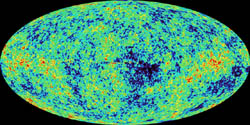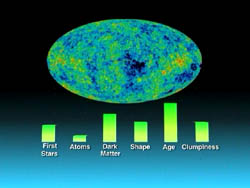Imagine the Universe News - 12 February 2003
NASA Releases Stunning Images Of Our Infant Universe
| 12 February 2003 |
|
NASA today released the best "baby picture" of the Universe ever taken; the image contains such stunning detail that it may be one of the most important scientific results of recent years.
Scientists using NASA's Wilkinson Microwave Anisotropy Probe (WMAP), during a sweeping 12-month observation of the entire sky, acquired the new cosmic portrait by observing the cosmic microwave background, which is the afterglow of the big bang.
"We've captured the infant universe in sharp focus, and from this portrait we can now describe the universe with unprecedented accuracy," said Dr. Charles L. Bennett of the Goddard Space Flight Center (GSFC), Greenbelt Md., and the WMAP Principal Investigator. "The data are solid, a real gold mine," he said.
The new portrait precisely pegs the age of the Universe at 13.7 billion years old, with a remarkably small one percent margin of error. In addition, the WMAP results indicate that the geometry of the universe is flat, so the Euclidean geometry you learned in high school applies over very large distances.
|
The WMAP team found that the Big Bang and Inflation theories continue to ring true. The contents of the universe include only 4 percent atoms (ordinary matter), 23 percent of a cold dark matter, and 73 percent of a mysterious dark energy. Scientist do not know what makes up the cold dark matter, and understand dark energy as a force acting against gravity which causes the universe to accelerate its expansion.
One of the biggest surprises revealed in the data is the first stars in the Universe began to shine only 200 million years after the big bang, much earlier than many scientists had expected.
"These numbers represent a milestone in how we view our universe," said Dr. Anne Kinney, NASA director for astronomy and physics. "This is a true turning point for cosmology."
The light we see today as the cosmic microwave background has traveled over 13 billion years to reach us. Within this light are infinitesimal patterns that mark the seeds of what later grew into clusters of galaxies and the vast structure we see all around us.
Patterns in the big bang afterglow were frozen in place only 380,000 years after the big bang, a number nailed down by this latest observation. These patterns are tiny temperature differences within the extraordinarily evenly dispersed microwave light bathing the universe, which now averages a frigid 2.73 degrees above absolute zero. WMAP detects slight temperature fluctuations, which vary by only millionths of a degree.
Theories about the evolution of the universe make specific predictions about the extent of these temperature patterns. Like a detective, the WMAP team compared the unique "fingerprint" of patterns imprinted on this ancient light with fingerprints predicted by various cosmic theories and found a match. WMAP's results can thus be used to rule out certain theories within the Inflationary Universe paradigm.
WMAP will continue to observe the cosmic microwave background for an additional three years, and its data will reveal new insights into the theory of Inflation and the nature of the dark energy.
"This is the beginning of a new stage in our study of the early universe," said WMAP team member Prof. David N. Spergel of Princeton University, N.J. "We can use this portrait not only to predict the properties of the nearby universe, but can also use it to understand the first moments of the big bang," he said.
WMAP is named in honor of David Wilkinson of Princeton University, a world-renown cosmologist and WMAP team member who died in September 2002.
Launched on June 30, 2001, WMAP maintains a distant orbit about the second Lagrange Point, or "L2," a million miles from Earth.
WMAP is the result of a partnership between the GSFC and Princeton University. Additional Science Team members are located at Brown University, Providence R.I., the University of British Columbia, Vancouver, BC, the University of Chicago, and the University of California, Los Angeles. WMAP is part of the Explorer program, managed by GSFC.




